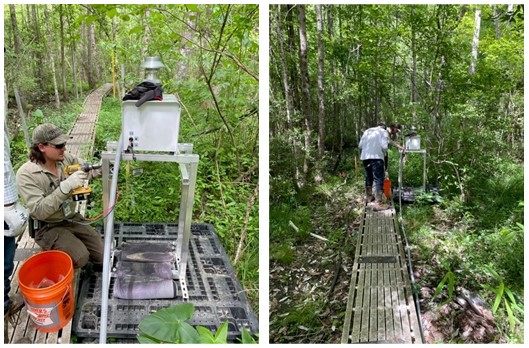June 8, 2023
Installation of Iodine Air Sampling System at the F-Area Wetlands
Savannah River National Laboratory (SRNL) worked with SRNS’s Area Completion Project (ACP) to deploy an iodine air sampling system in the F-Area wetlands on May 15-16, 2023. This system will support an applied research task to determine whether 129I present in F-Area wetland surface water and sediments becomes airborne, and if so, to what degree. Possible seasonal variations in iodine air concentrations will also be evaluated through continuous monitoring over the course of about a year.
The F-Area wetlands are a known sink for radioiodine generated at SRS. Waste containing iodine-129 (129I) was discharged into the F-Area Seepage Basins, which later became mobile due to changes in the natural geochemistry of the vadose zone and aquifer. This contaminant has migrated to the nearby F-Area wetlands, where it is accumulating and resurfacing. Changes in biogeochemical conditions could result in the release of this sequestered 129I, creating a secondary source zone. Further, it has been reported that 129I contributed approximately 23% to the 2019 SRS offsite air pathway dose, but air measurements for this contaminant have never been taken in the F-Area wetlands. Therefore, this research aims to evaluate whether 129I in the F-Area wetlands is emitted to the air and whether air concentrations exhibit seasonal variation.
The system installed includes a battery-operated sampler (CF-5624-WR; Hi-Q Environmental Products Company, Inc.) fit with custom inlet that holds a charcoal cartridge (Figure 1). Power to the system is supplied through a battery bank, which is recharged via solar panels (Figure 2). System components were transported to the installation site using an Argos side-by-side and assembled by SRNL and ACP Maintenance team members. The air sampler was bolted to a metal frame and positioned on a plastic pallet to the side of a nearby boardwalk that extends out towards several groundwater seeps. The stand was weighted to the pallet using sandbags and secured to several nearby points to prevent tipping. The solar panels and battery bank used to power the sampler were installed approximately 100 ft uphill. All wiring between the air monitor and solar panels was wrapped in flexible conduit to prevent damage by weather or animals. The battery bank is made up of four GEL batteries, all placed inside of a weatherproof enclosure. The solar panels were mounted on top of the battery enclosure and oriented facing South. The system was installed nearby to both surface water stations and groundwater seeps to allow for possible correlation with surface water 129I concentrations. Air will be sampled continuously at this one location within the F-Area wetlands for one year. Samples will be collected every two weeks and analyzed to determine total 129I concentrations.


